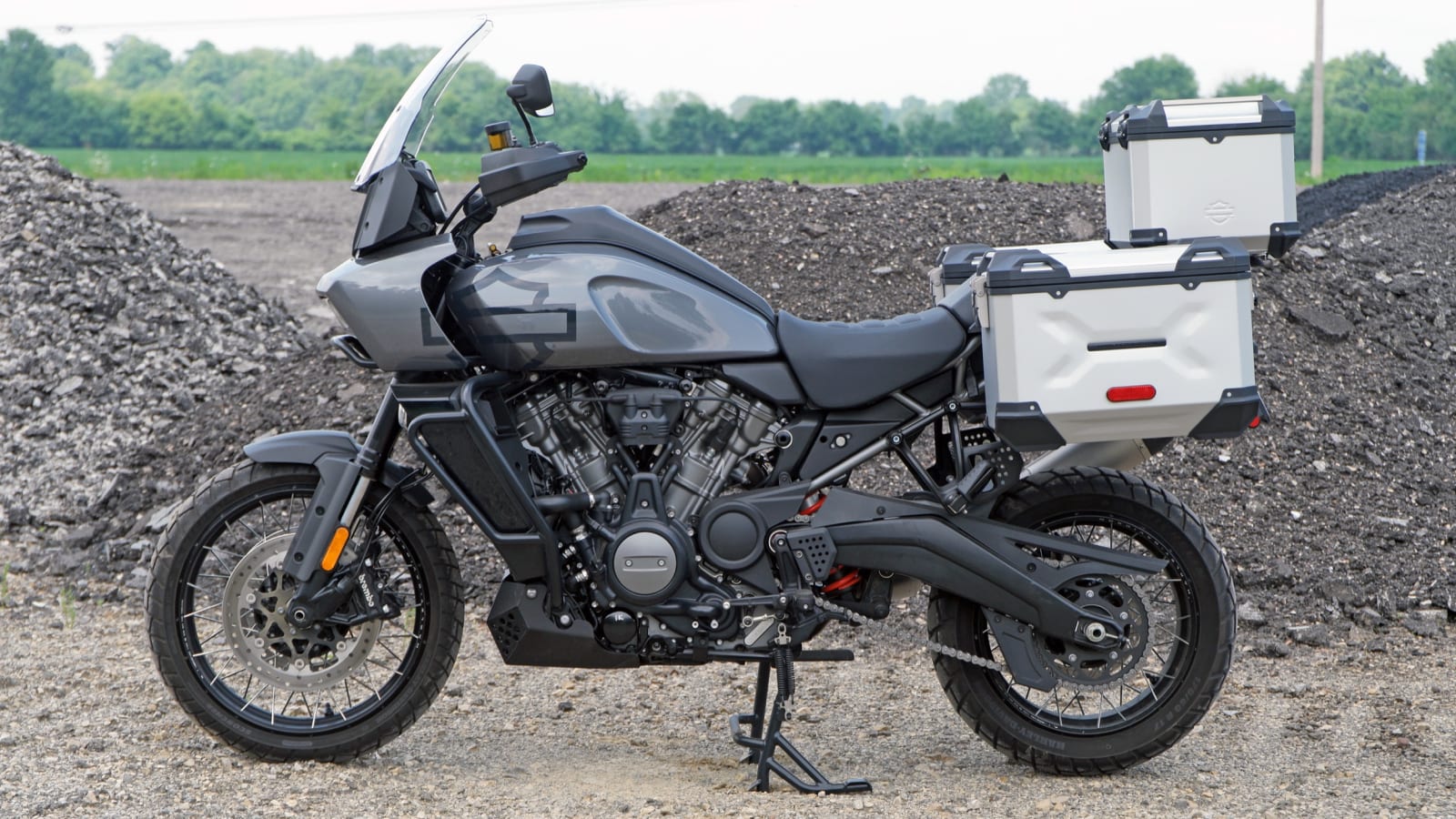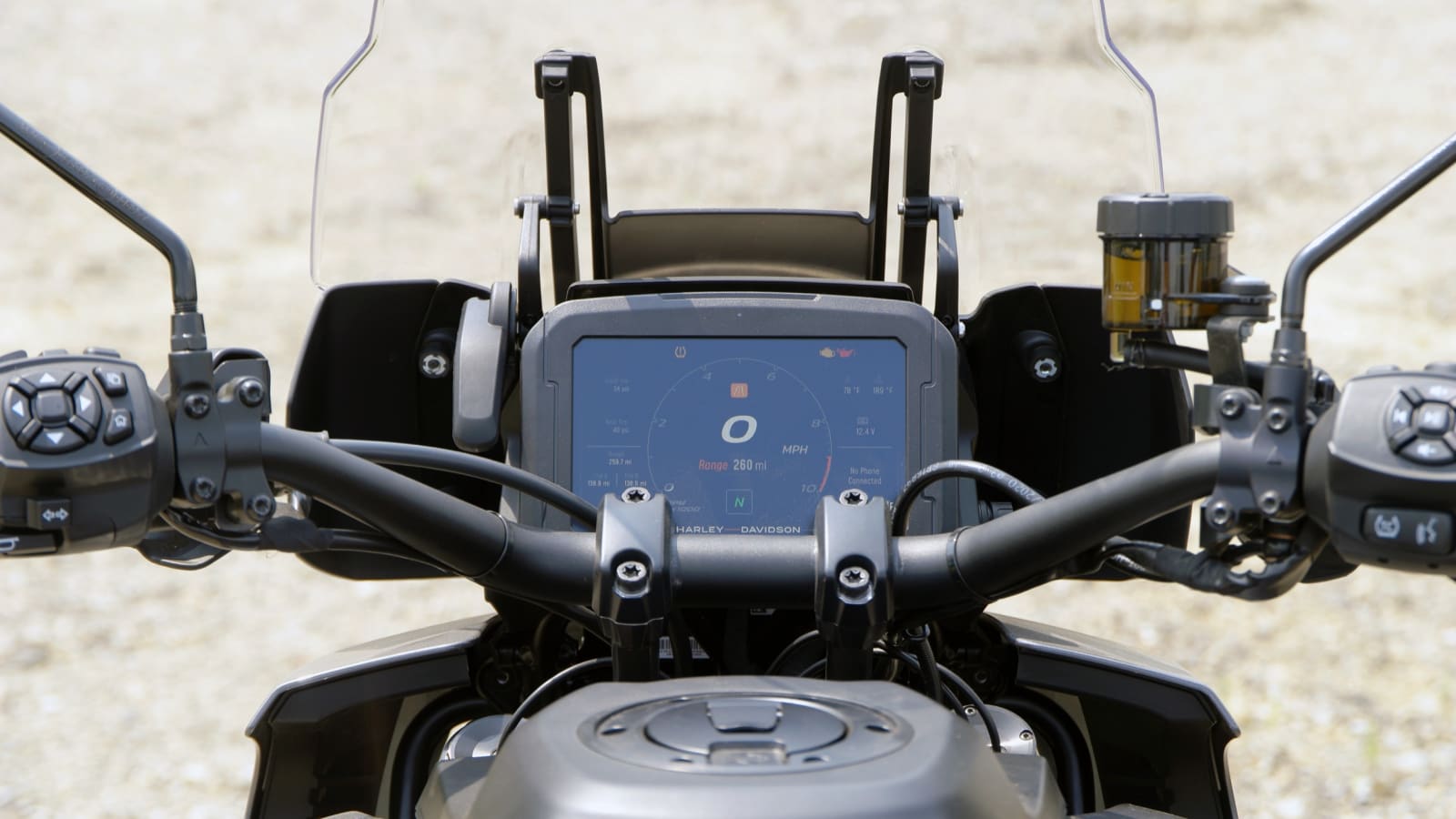The Harley-Davidson Pan America 1250 is an excellent adventure touring motorcycle. The fact that it’s the brand’s first real entry into the segment is impressive — no, I didn’t forget the Buell Ulysses, which was neither badged a Harley-Davidson nor a direct competitor to other bikes in the segment — but the Pan America isn’t just good for an opening salvo, it’s just plain good. And the happy story all starts with the bike’s all-new liquid-cooled engine.
Harley’s new 60-degree V-twin engine displaces 1,252cc, features dual overhead camshafts with variable timing, dual spark plugs and a 13.0:1 compression ratio. The use of hydraulic valve adjusters means they’ll never need adjustment, something its main German rival can’t claim. The Revolution engine spins out 150 horsepower at 9,000 rpm and 94 pound-feet of torque at 6,750 (running premium gasoline; output will be reduced on regular unleaded). It’s basically the exact opposite of most any other V-twin from H-D, with power that starts reasonably low but builds quickly as the revs climb, never letting up before each 9,000-rpm shift of the six-speed gearbox. Not surprisingly for a Harley-branded bike, the Revolution engine looks good, too.
Harley has included Road, Rain, Off-Road and Off-Road Plus modes that are selected using buttons on the handlebars. A 6.8-inch color display shows all the current settings, along with all of the information you’d otherwise expect from the gauge cluster. Each of these modes adjust everything from the engine’s power output to suspension and ABS brake settings. The electronic suspension that comes on Pan America Special models like our test bike also offers several modes. Sport, Road and Comfort are all self explanatory, and the difference between Off-Road Soft and Off-Road Firm are easily felt from the saddle.
Adaptive Ride Height, which adds an additional $1,000 to the cost of the Pan America Special, can drop the seat height to just below 30 inches at low speeds, starting its adjustment at 15.5 mph. An optional low seat brings that number all the way down to about 28 inches for shorter riders. Stock, the Pan America’s unladen saddle is 33.4 inches off the ground in the low position or 34.4-inches in the high position. This wide range of adjustability makes the Pan America one of the most versatile bikes in the adventure segment, accessible to riders with shorter inseams who may otherwise have a hard time balancing a heavy bike below walking speeds. It’s also possible to turn off Adaptive Ride Height to maintain maximum clearance.
The semi-active suspension system automatically adjusts to maintain 30% suspension sag regardless of how much weight the bike is carrying. There’s 7.5 inches of suspension travel and 8.3 inches of ground clearance, and if you exceed that limit, the big burly skidplate of our Pan America Special model felt durable enough to prevent damage to anything important. The Pan America 1250 weighs in at 534 pounds wet, while the Special bumps that up to 559 pounds due to additional equipment that includes engine guards, a center stand, hand guards, heated grips, a tire-pressure monitor and an Ohlins steering damper. It’s heavy but well balanced and not so unwieldy that I had any problems getting it up onto its center stand.
A manually adjustable windshield with a pistol-grip handle is designed to direct the oncoming wind blast where the rider wants it, but even in its most upright position (which is oddly at its second-to-last setting) it can’t push the bubble entirely over a tall rider’s helmet. Most of the rest of the controls are fairly easy to use from the saddle. Problem is, there are so many buttons and switches on the handlebars — an issue in this segment that’s not unique to Harley-Davidson — that riders are going to have to get to know them really well before hitting the road. And even though the digital dash is bright, crisp and well-sized, some of the readouts are too small to see without taking your eyes off the road for too long.
The Revolution engine, which unlike most H-D V-twins shares a case with the transmission, is a stressed member of the frame. There’s a front frame, a mid frame and a subframe at the rear that supports the rider and passenger. The end result is a stiff chassis that lets the front and rear suspension systems work efficiently. On-road handling is very good, with easy transitions from left to right, and plenty of available lean angle. Rolling into the throttle provides strong thrust, and in part because the traction control adjusts its sensitivity based on lean angle, the bike instills a sense of confidence to keep exploring its limits.
I spent most of our time riding in Road mode. It never rained during our week with the Pan America, but it was obvious that Rain mode cuts power and throttle sensitivity. The two Off-Road modes are useful, naturally, off road. The standard Off-Road mode eases the power delivery and amps up the traction control and linked ABS brakes. Off-Road Plus reduces traction control intervention and allows experienced riders to lock up the brakes. Traction control is fully defeatable, allowing for tail-out antics on the dirt.
I rode the bike with its stock Michelin Scorcher Adventure tires, so I didn’t venture too far off into the rocks or mud. Heavy gravel and loose sand did cause the bike to wander a bit, but its good weight distribution (though I had a backpack with 20 pounds of gear in the top case), solid ergonomics and rational geometry meant that it never felt so hairy that I needed to slow down. One side effect of relatively low-speed riding is that there isn’t enough airflow to push hot air away from the engine, and the Pan America’s powerplant puts out a lot of heat.
Out of the dirt and onto the highway, the first thing that becomes obvious when riding the Pan America is that it’s got plenty of power. Accelerating up to extra-legal speeds is a flick of the wrist and a couple of left-toe gear changes away, and the strong upper-rpm punch makes passing 18-wheelers a cinch.
One of the best things about this class of bikes is that they can switch between on- and off-pavement adventures at the rider’s whim. The Pan America executes this transition very well, despite an obvious bias toward the asphalt. All the electronic doodads outlined above work wonders to alter the Pan America’s dynamics from sporty tourer to capable off-roader, particularly the adjustable suspension and engine maps.
By now, it should be obvious that I think Harley-Davidson has made an excellent adventure touring motorcycle. After all, I said as much right off the bat. And at $17,319 for the base model or $19,999 for the Special model that I tested, it’s even priced competitively. Thing is, there are several very good adventure bikes that H-D is competing with, not the least of which is the segment-defining BMW R 1250 GS. Is the Pan America better than its rivals? No, not really. But it’s right in the ballpark, and that’s a major win for the American brand that needs nothing more than to bring new riders into its showrooms.
Related video:






